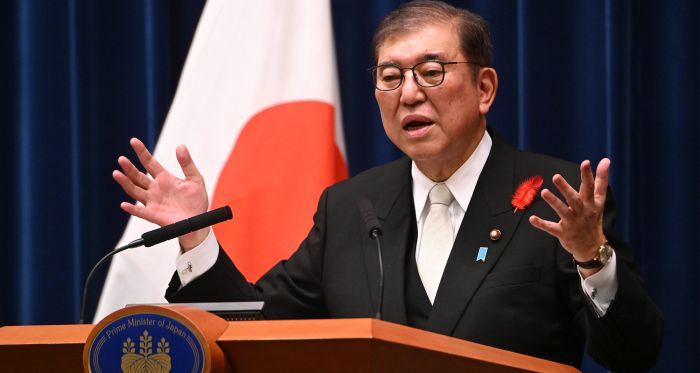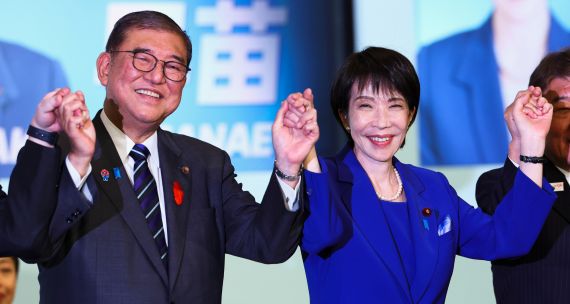L’élection de Shigeru Ishiba, qui a remporté le 1er octobre dernier sa course à la chefferie pour devenir le nouveau premier ministre du Japon, reflète les divisions au sein du Parti libéral démocrate (LDP) entre le centre droit et la droite plus affirmée.
La mince marge de victoire de M. Ishiba contre la très conservatrice Sanae Takaichi au deuxième tour de l’élection interne démontre que le LDP est encore en pourparlers afin de déterminer quel type de parti il souhaite devenir après le décès de l’ancien premier ministre Shinzo Abe, président de longue date du LDP et lui aussi très conservateur, qui a occupé le poste de premier ministre de 2012 à 2020 avant son assassinat en 2022.
Cette introspection mène le parti à se questionner sur quelles idéologies constituent la base de sa philosophie actuelle et nationale, quelles sont ses politiques économiques et quel niveau de sécurisation des politiques étrangères les membres sont prêts à accepter.
M. Ishiba ne plaidera pas en faveur de politiques de migration libérale, ne promouvra pas activement l’égalité des genres ni toute autre forme d’égalité, et ne divergera pas de la stratégie de sécurité nationale japonaise de 2022.
En réalité, M. Ishiba, ancien ministre de la Défense, a plaidé en faveur de la mise sur pied d’une OTAN asiatique et pour que des membres des Forces d’autodéfense du Japon, l’armée du pays, soient basés aux États-Unis. Il a même visité Taïwan avant les élections pour mettre en valeur l’importance de l’île pour la sécurité japonaise.
Le soutien envers le leadership de M. Ishiba est précaire. Au cours du processus électoral interne du LDP, ce n’est que lorsque le premier ministre sortant Fumio Kishida a manifesté son soutien envers la candidature de M. Ishiba que ce dernier a pu remporter une modeste victoire contre la conservatrice favorite Sanae Takaichi, proche alliée de l’ancien premier ministre Abe.
Le peu de nominations de conservateurs dans le cabinet de M. Ishiba laisse croire qu’il pourrait sérieusement envisager de transformer l’orientation idéologique du LDP. De plus, en nommant l’ancien premier ministre Yoshihide Suga comme vice-président du LDP, et en excluant donc Taro Aso, M. Ishiba démontre qu’il cherche à enrayer l’influence de la vieille garde conservatrice dans le LDP et à transitionner vers le centre droit.
Toutefois, cela s’avérera difficile. La vieille garde conservatrice n’a jamais hésité à exercer des pressions pour pousser le premier ministre en poste à démissionner. À titre d’exemple, entre 1997 et 2012, le Japon a eu pas moins de huit premiers ministres.
Des attentes intérieures qui n’impressionnent pas
Sur le plan intérieur, la continuité politique est vraisemblablement du côté de l’administration Ishiba. Concrètement, les politiques instaurées sous Shinzo Abe, y compris les soi-disant trois flèches (« Abenomics »), se poursuivront avec des réformes modestes. Il faut s’attendre à davantage d’investissement dans les mesures visant à promouvoir les familles alors que les graves problèmes démographiques du Japon persistent, ainsi qu’à une réforme modeste de la migration pour permettre à un plus grand nombre de travailleurs non qualifiés de travailler dans ces pans de l’économie japonaise auxquels les citoyens japonais tournent le dos. Il existe également une possibilité que M. Ishiba normalise le mariage entre personnes de même genre si son mandat se prolonge au-delà d’un an.

Il y a un consensus au sein du LDP quant à la nécessité d’investir davantage dans les initiatives de sécurité et de résilience économiques à la suite de l’invasion de l’Ukraine par la Russie, des expériences passées de coercition économique et de diplomatie des otages et de l’éventuelle rupture ou l’utilisation des chaînes d’approvisionnement à des fins de stratégie géopolitique. Une administration Ishiba est susceptible de continuer de renforcer ces politiques emblématiques.
Les premiers ministres japonais disposent de peu d’options lorsqu’il s’agit de fondamentalement transformer la structure socio-économique du pays en peu de temps. Prenons l’exemple de Shinzo Abe : bien qu’il ait été au pouvoir pendant près de huit ans et a représenté une force politique dominante au sein du LDP, il n’a pas accompli de progrès considérables sur la réforme de la pension et du bien-être social, la numérisation, l’égalité des genres et n’a pas rendu possible une plus grande mobilité horizontale et verticale sur le marché du travail.
L’historique de M. Ishiba en tant que quidam dans son parti laisse croire qu’il pourrait ne pas être en mesure d’accroître le soutien au sein du LDP afin d’entraîner une réforme économique suffisante pour résoudre les nombreux problèmes économiques et sociaux du Japon.
Occasions de politique étrangère et limites d’une politique chinoise sécurisée
En incluant deux anciens ministres de la Défense dans son nouveau cabinet, M. Ishiba envoie aux membres des deux partis et à la société japonaise le message qu’il traite avec le plus grand sérieux les menaces à la sécurité de la Chine, de la Russie et de la Corée du Nord.
Toutefois, sa proposition d’une OTAN asiatique a été reçue avec scepticisme par Washington. L’hétérogénéité de la région en matière de politique, d’économie et de défis de sécurité rend cette idée difficile à concrétiser, tout comme le fait que la plupart des pays de la région ne veulent pas avoir à choisir entre la Chine et les États-Unis.
La surenchère de sécurisation des relations entre le Japon et la Chine comporte également certaines limites. La Chine, qui perçoit toujours le Japon comme une source d’investissement, de technologie et de développement de capital humain, accueille plus de 20 000 petites et moyennes entreprises japonaises, et les relations commerciales bilatérales en date de 2023 s’élevaient à environ 380 milliards $ US. Cette relation commerciale mutuellement avantageuse continue de s’approfondir même si les tensions en matière de sécurité ainsi que la perception du public atteignent des niveaux inégalés d’avis défavorables dans les deux pays.
Entretemps, renforcer les relations du Japon avec Taïwan ne ferait qu’inciter Beijing à user de coercition économique, de diplomatie des otages ou de toute autre tactique visant à indiquer à l’administration Ishiba que si elle s’écartait de la politique d’une seule Chine, elle dépasserait les limites de l’acceptable.
Toutefois, M. Ishiba pourrait trouver une autre manière de manœuvrer dans le domaine de la politique étrangère. En voici quelques exemples : investir dans des partenariats existants tels que l’alliance Japon–États-Unis; les accords d’accès réciproques avec l’Australie, le Royaume-Uni et les Philippines; le Dialogue quadrilatéral pour la sécurité; élargir l’effectif du PTPGP; investir dans de nouveaux accords minilatéraux.
Plusieurs pays perçoivent le Japon comme un « adaptateur » international et comme une puissance intermédiaire qui aide les pays à créer des liens entre eux et avec des associations dans l’Indo-Pacifique. À titre d’exemple, avec le PTPGP, le Japon était indispensable pour amener les économies développées et en voie de développement à bâtir cet accord commercial du 21e siècle.
Le Japon a également utilisé le Quad et les partenariats minilatéraux entre les Philippines, les États-Unis et lui-même pour entreprendre des initiatives d’infrastructure et de connectivité, des transferts de technologies et d’autres projets.
Shigeru Ishiba, tout en travaillant avec des alliés et des partenaires, peut étendre la portée de la coopération internationale du Japon. Par exemple, il pourrait proposer de travailler avec le Canada, les Philippines, le Vietnam et l’Indonésie sur la pêche illicite, non déclarée et non réglementée. Quant au commerce, il pourrait plaider en faveur de l’expansion du PTPGP avec de nouveaux membres, y compris la Corée du Sud, la Thaïlande, les Philippines et même la Chine et Taïwan.
En ce qui a trait à la lutte contre la désinformation, M. Ishida pourrait trouver une façon de travailler avec des partenaires qui sont à l’avant-garde pour relever ce défi mondial en proposant de mettre sur pied un consortium non étatique d’instituts de recherche ou d’organisations spécialisées dans l’identification, l’atténuation de la désinformation, ainsi que dans la lutte et la protection de nos sociétés contre celle-ci.
Les défis internes du parti détermineront la longévité du mandat de premier ministre de Shigeru Ishiba
Même si M. Ishiba est à la tête du parti depuis peu, il ne bénéficie au mieux que d’un soutien marginal dans le LDP. Sans une meilleure base de soutien, il sera difficile pour lui d’élaborer et de mettre en œuvre des politiques, surtout dans un contexte d’opposition au sein du parti venant de politiciens plus conservateurs.
Le premier ministre Ishiba a lancé des élections générales le 27 octobre 2024. Celles-ci seront déterminantes pour la longévité de son mandat. Un faible résultat du LDP pourrait avoir des répercussions négatives sur l’attractivité de M. Ishiba en tant que chef d’État ainsi que du cabinet qu’il a mis sur pied. Si le LDP ne parvient pas à obtenir de bons résultats, les adversaires politiques de M. Ishiba tenteront de le remplacer. Si le parti réussit, M. Ishiba pourrait gagner du temps ainsi que du capital politique pour appliquer certaines de ses promesses électorales.
Pourquoi est-ce important pour le Canada?
Ce qui se passe au Japon est important pour le Canada. Il s’agit d’un partenaire commercial majeur et prioritaire dans la Stratégie du Canada pour l’Indo-Pacifique. Avec des relations bilatérales moins qu’idéales avec l’Inde et la Chine, le Canada pourrait difficilement se permettre de voir le Japon retomber dans un cycle de premiers ministres changeants ou sans majorité. Pour faire face à cette possibilité, Ottawa devrait chercher à isoler ses lignes de coopération au plan institutionnel. Cela nécessitera davantage d’échanges entre militaires, entre parlementaires et entre entreprises. Ottawa pourrait également travailler avec le nouveau gouvernement japonais sur des initiatives visant à accroître le capital politique tant à Tokyo qu’à Ottawa, notamment en élargissant le PTPGP, en travaillant de concert pour faire du lobbyisme en matière d’élections présidentielles américaines après à 2024, et plus encore.





